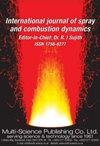Liquid jet breakup unsteadiness in a coaxial air-blast atomizer
IF 2.1
4区 工程技术
Q3 ENGINEERING, MECHANICAL
International Journal of Spray and Combustion Dynamics
Pub Date : 2018-03-22
DOI:10.1177/1756827718760905
引用次数: 29
Abstract
The aim of this paper is to experimentally characterize the liquid jet breakup unsteadiness in a coaxial air-blast atomizer. The current research focuses on the measurement of the fluctuations of the jet breakup length and the flapping instability of the liquid jet, which contribute to the downstream fluctuations of the spray characteristics. The optical connectivity technique was used to measure the instantaneous breakup length of the water jet. Also, time resolved shadowgraph images of the primary jet breakup process were captured by high-speed imaging to characterize the jet instabilities at different axial locations from the atomizer exit. Experiments were performed for a wide range of air-to-liquid momentum flux ratio (M) and aerodynamic Weber number (Weg) corresponding to membrane- and/or fiber breakup mode of the jet disintegration process. The mean jet breakup length was found to vary inversely with M through a power law relation in agreement with the literature, while the breakup length fluctuations were found to first decrease and then increase with M. In order to capture the unsteady dynamics of the jet breakup process, the proper orthogonal decomposition analysis of the optical connectivity images was performed. The jet flapping and the fluctuations of the jet breakup length were identified as the second and the third spatial proper orthogonal decomposition modes, respectively, for all operating conditions of the atomizer. The amplitude and the frequency of the instabilities were measured by temporal tracking of the liquid–air interface on the shadowgraph images. The disturbance close to the injector exit corresponds to the Kelvin–Helmholtz instability, while close to the jet breakup point the jet exhibits the flapping instability, which is characterized by lateral oscillation of the jet about the atomizer axis. The influence of the liquid jet Reynolds number and momentum flux ratio on the KH and the flapping instabilities are examined.同轴空气射流雾化器中液体射流破裂的不稳定性
本文的目的是通过实验表征同轴空气喷射雾化器内液体射流破碎的非定常。目前的研究重点是测量射流破碎长度的波动和液体射流的扑动不稳定性,它们导致了射流特性的下游波动。利用光连通性技术测量了水射流的瞬时破裂长度。此外,利用高速成像技术捕获了一次射流破碎过程的时间分辨阴影图像,以表征喷嘴出口不同轴向位置的射流不稳定性。对射流解体过程中膜和/或纤维破碎模式对应的气液动量通量比(M)和气动韦伯数(Weg)进行了大范围的实验。平均射流破碎长度随M的变化呈幂律关系,与文献一致,而射流破碎长度波动随M先减小后增大。为了捕捉射流破碎过程的非定常动力学,对光学连接图像进行了适当的正交分解分析。在雾化器的所有工况下,射流扑动和射流破碎长度波动分别被确定为第二和第三空间固有正交分解模式。利用阴影图像对液气界面进行时域跟踪,测量了不稳定性的幅度和频率。在喷油器出口附近的扰动对应于开尔文-亥姆霍兹不稳定性,而在射流破裂点附近的扰动表现为扑动不稳定性,其特征是射流围绕雾化器轴的横向振荡。研究了液体射流雷诺数和动量通量比对KH和扑动不稳定性的影响。
本文章由计算机程序翻译,如有差异,请以英文原文为准。
求助全文
约1分钟内获得全文
求助全文
来源期刊

International Journal of Spray and Combustion Dynamics
THERMODYNAMICS-ENGINEERING, MECHANICAL
CiteScore
2.20
自引率
12.50%
发文量
21
审稿时长
>12 weeks
期刊介绍:
International Journal of Spray and Combustion Dynamics is a peer-reviewed open access journal on fundamental and applied research in combustion and spray dynamics. Fundamental topics include advances in understanding unsteady combustion, combustion instability and noise, flame-acoustic interaction and its active and passive control, duct acoustics...
 求助内容:
求助内容: 应助结果提醒方式:
应助结果提醒方式:


